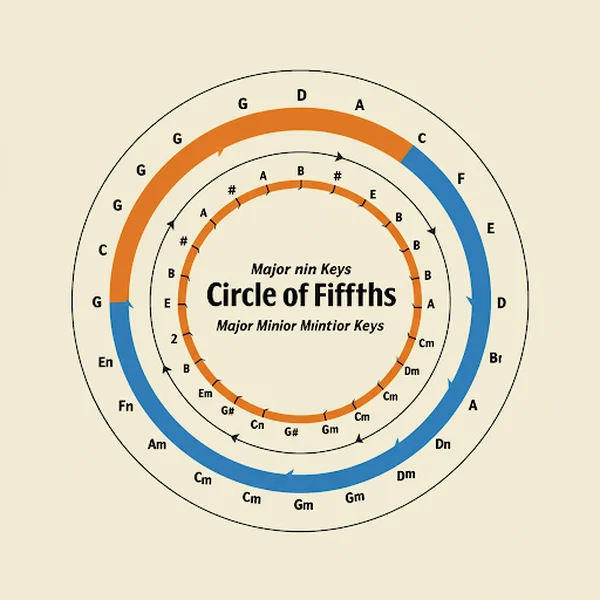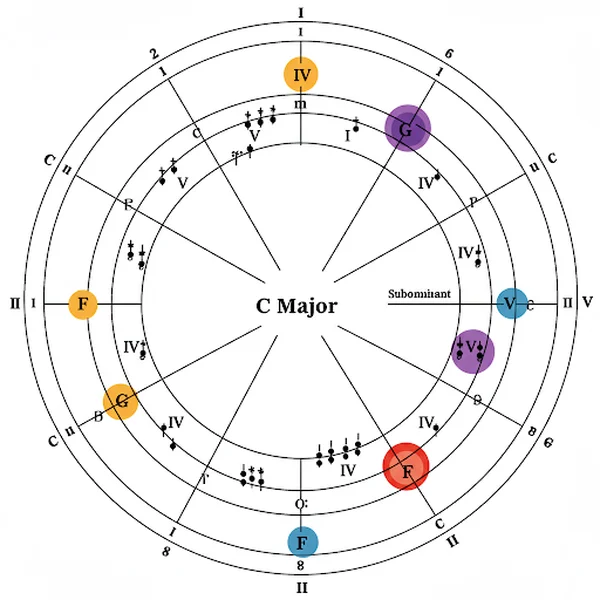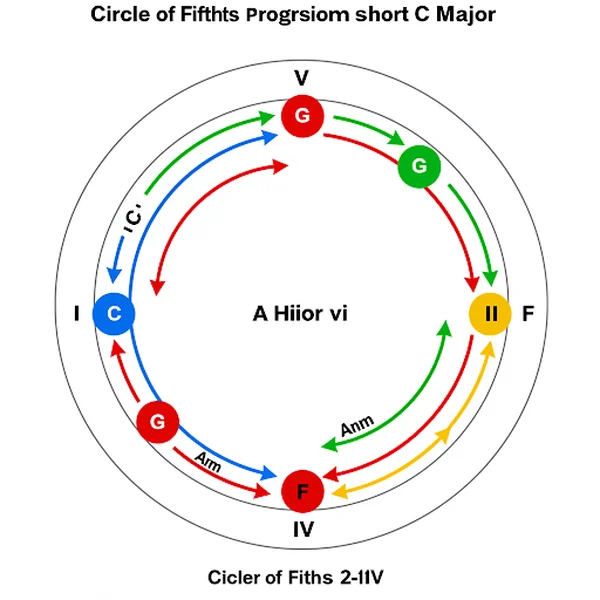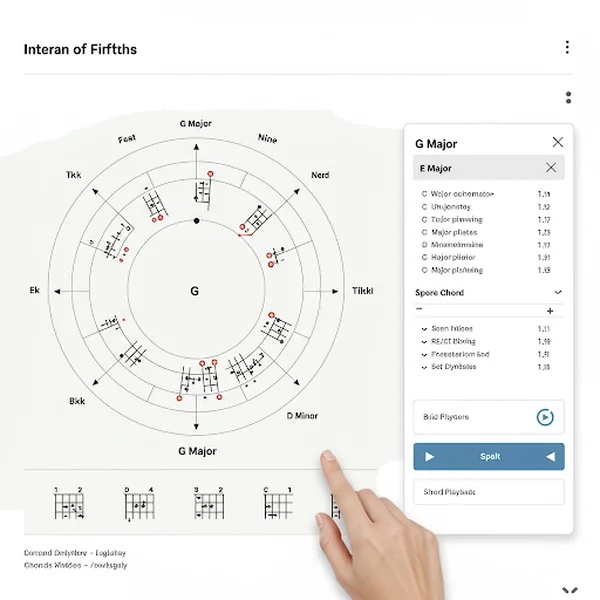Build Chord Progressions with the Circle of Fifths
Unlock Songwriting: Using the Circle of Fifths for Chord Progressions
Feeling stuck staring at a blank page, wondering how to create chord progressions that truly resonate? How does the circle of fifths help songwriting? For countless musicians, composers, and songwriters, the Circle of Fifths isn't just a theoretical diagram; it's a powerful map for unlocking harmonic possibilities and building compelling chord progressions. If you've ever found yourself randomly guessing chords or relying on the same tired patterns, this guide is for you. We'll explore how this elegant musical tool can demystify chord relationships and become your go-to assistant for crafting engaging music. Let's dive in and discover how our interactive tool can help.
Understanding Chord Relationships on the Circle of Fifths
What chords are in the circle of fifths? At its core, the Circle of Fifths visually organizes all twelve chromatic pitches according to perfect fifth intervals. This layout immediately reveals crucial relationships between chords, forming the foundation for building progressions.

The Power of Proximity: Adjacent Chords (Fifths & Fourths)
Look at any key on the circle. The keys immediately clockwise (a perfect fifth up) and counter-clockwise (a perfect fourth up, or a fifth down) have the strongest harmonic relationship to it. For instance, in the key of C Major, G Major (V chord, dominant) is one step clockwise, and F Major (IV chord, subdominant) is one step counter-clockwise. This proximity signals chords that naturally lead to or resolve back to the tonic, creating a sense of movement and resolution crucial for music theory chords.
Expanding Your Palette: Relative Major and Minor Chords
The Circle of Fifths also clearly displays the relationship between major keys and their relative minors. They share the same key signature. On the inner ring (or often shown alongside), you'll find the relative minor key for each major key (e.g., C Major and A minor). Understanding this connection opens up a vast palette of emotional colors, allowing you to seamlessly weave relative minor chords into your major key progressions for added depth and nuance.
Visualizing Connections: How the Circle Maps Harmony
Think of the Circle as a visual blueprint for harmony. The closer two keys/chords are on the circle, the more closely related they typically sound. This visual representation makes complex harmonic relationships intuitive, taking the guesswork out of finding chords that work well together.
Finding Key Chords: Tonic, Dominant, and Subdominant
Every key has primary chords that establish its tonal center. The Circle of Fifths makes identifying these effortless.

Locating Your Home Base: The Tonic (I) Chord
Your starting point on the circle represents the tonic key and its corresponding major (I) or minor (i) chord. This is the chord that feels like "home" in your progression, the point of resolution.
Identifying the Pull: The Dominant (V) Chord
Move one step clockwise from your tonic. This is the dominant key, and its major chord (V) creates the strongest pull back towards the tonic. The V-I cadence is one of the most fundamental and satisfying movements in Western music, clearly visualized by this adjacent relationship on the circle. Using the dominant chord effectively creates tension and release.
Finding Stability: The Subdominant (IV) Chord
Move one step counter-clockwise from the tonic. This is the subdominant key, and its major chord (IV) provides a sense of stability and often precedes the dominant chord (e.g., IV-V-I). These three chords (I, IV, V) are the pillars of most simple key chords progressions.
Building Common Chord Progressions Step-by-Step
Now for the fun part: using the circle to build actual progressions. How do I build chord progressions? Let's look at some examples.

The Ubiquitous ii-V-I Progression Explained
This cornerstone of jazz and pop is easily mapped on the circle. In a major key (like C), find the tonic (C). The V chord is G. The ii chord is the minor chord built on the second scale degree (D minor). Notice that D is two steps clockwise from C, and G is one step clockwise. Moving counter-clockwise: C -> F -> Bb -> Eb -> Ab -> Db/C# -> F#/Gb -> B -> E -> A -> D -> G -> C. The ii (Dm), V (G), and I (C) are closely related on the circle, often appearing near each other, making the ii-V-I progression feel natural.
Mastering the I-V-vi-IV Pop Progression
Arguably one of the most used common chord patterns in pop music. In C Major:
- I: C (Tonic)
- V: G (One step clockwise)
- vi: Am (Relative minor of C, found on the inner circle)
- IV: F (One step counter-clockwise) The Circle helps visualize how these fundamental chords relate, making the I-V-vi-IV pop progression easy to understand and transpose. (See image above for visualization).
Exploring Movement: Other Patterns like I-IV-V
Even the simplest I-IV-V progression is right there: Tonic (I), Subdominant (IV - counter-clockwise), Dominant (V - clockwise). You can see how moving between these adjacent 'strong' chords creates classic sounds. Experiment with moving between chords close to each other on the circle to discover more common chord patterns.
Applying the Patterns: From Theory to Music
The goal isn't just to identify these patterns but to hear them and use them. Grab your instrument or use a songwriting tool and play through these progressions in different keys, using the Circle of Fifths as your guide.
Adding Flavor: Using Secondary Dominants & Minor Chords
Ready to spice things up? The Circle is still your friend.
Incorporating Emotion with Relative Minor Chords
Don't just stick to the major chords. Swapping a major chord for its relative minor (or vice-versa) or simply adding the relative minor (like the vi chord in I-V-vi-IV) adds instant emotional depth. The Circle makes finding these relative minor chords trivial. Can I use the circle for minor keys? Absolutely, the relationships (like relative major/minor) hold true, and the circle helps visualize minor key progressions too.
Finding Secondary Dominants on the Circle
Want to temporarily make a chord other than the tonic feel like home? Use its dominant! For example, in C major, the V chord is G. What's the dominant of G? Look one step clockwise from G on the circle – it's D. So, a D Major chord (or D7) acts as a V/V (V of V), creating a strong pull towards G. While secondary Dominants are a deeper topic, the circle provides the map to find the V chord of any target chord.
Leverage the Interactive Circle of Fifths Tool
Reading about it is one thing, but seeing and hearing it makes all the difference.

Visualize Chord Options Instantly
Our interactive tool brings the Circle of Fifths to life. Click on any key, and instantly see its major/minor chords, relative keys, and common neighboring chords highlighted. It’s the perfect way to visualize chord options instantly. (See the tool interface in the image above).
Hear Your Ideas: Using the Chord Playback Feature
Unsure how a progression sounds? Our tool often includes chord playback (check features!), allowing you to audition chord sequences directly. This auditory feedback accelerates learning and helps you make better creative choices.
Experiment Freely: Your Digital Songwriting Assistant
Think of the website's tool as your personal songwriting assistant. Use it to explore different keys, test out progressions, discover new harmonic possibilities, and break free from creative blocks. It's an invaluable resource for music composition.
Start Crafting Better Chord Progressions Today!
The Circle of Fifths is far more than a static chart; it's a dynamic tool for understanding harmony and sparking creativity. By visualizing chord relationships, identifying key chords, and mapping out common patterns, you can move beyond guesswork and start building intentional, effective chord progressions. Ready to put theory into practice? Why not start exploring here and see where the circle takes your music? What are your favorite progressions discovered using the Circle of Fifths?
Chord Progressions & The Circle of Fifths
-
What are the most common chord progressions found using the Circle of Fifths?
Many common progressions involve movement between adjacent chords (V-I, IV-I), relative majors/minors (I-vi), and patterns like ii-V-I and I-V-vi-IV, all easily visualized on the circle. Exploring chords within a segment of the circle often yields good results.
-
Can the Circle of Fifths help me write progressions in minor keys?
Yes! The principles are the same. You can start on a minor key (inner circle) and find its relative major, dominant (often major, V), and subdominant (often minor, iv). The relationships and proximity still guide you in building minor key chord progressions.
-
How do I know which chords sound good together using the circle?
Generally, chords closer together on the Circle of Fifths tend to sound more closely related and consonant. Moving in fourths (counter-clockwise) or fifths (clockwise) creates strong, natural-sounding movements. Experimenting is key, and using an interactive circle tool lets you hear these relationships quickly.
-
Is the Circle of Fifths the only way to write chord progressions?
No, it's not the only way, but it's an incredibly powerful and fundamental tool. Many other harmonic techniques exist (modal interchange, chromaticism, etc.), but understanding the relationships shown by the Circle provides a solid foundation for almost all tonal music songwriting.